Comments / Questions (50)
![]() Susan Orton wrote:
Susan Orton wrote:
Your pattern, Mistletoe Muse is being sold on Etsy by another person who obviously isn't you. If you do a Google Image search on your sweater, it will pop up under Etsy and it isn't a DROPS account who is posting it. Sorry, it wouldn't allow me to post a link here.
05.12.2025 - 16:32
![]() Edyta wrote:
Edyta wrote:
Planuję wykonać sweter w rozmiarze M.
16.10.2025 - 12:43DROPS Design answered:
Witaj Edyto, używając Alaski otrzymasz dużo cięższy sweter. Potrzebować będziesz 9 motków w podstawowym kolorze (tutaj pszeniczny) i po 2 motki pozostałych kolorów. Pozdrawiamy!
16.10.2025 - 12:51
![]() Edyta wrote:
Edyta wrote:
Hi. I'm going to knit a sweater with Alaska yarn. Can you tell me please what amount of yarn should I use for each colour?
16.10.2025 - 11:19DROPS Design answered:
Witaj Edyto, jaki rozmiar wykonujesz?
16.10.2025 - 11:26
![]() Grażyna Wypiór wrote:
Grażyna Wypiór wrote:
Dzień dobry ponieważ mogę nosić tylko bawełnę czy jest możliwość doboru takich samych kolorów? chodzi o sweterek Mistletoe Muse ?
09.09.2025 - 14:41DROPS Design answered:
Witaj Grażyno, z palety włóczki Paris, która jest z tej samej grupy włóczek co włóczka Air (czyli C): kolejność jest taka sama jak w legendzie do schematu: 67 pszeniczny, 26 ciemny beż, 44 brąz, 59 jasny stary róż, 71 mandarynka, 37 rdzawo-czerwony, 35 żółty, 78 mięta pieprzowa. Miłej pracy!
09.09.2025 - 20:56
![]() Ute Smania wrote:
Ute Smania wrote:
Ich habe die Arbeit nun geteilt und fange mit dem Rumpf an. Jetzt steht in der Anleitung, dass ich im Muster A.2 weiter stricken soll, bis der A.2-Rapport in der Höhe fertig gestrickt ist, danach A.3. Da in A2 viele Zunahmen enthalten sind, würde der Rumpf doch zu weit. Ich kann aber die angezeigten Umschläge nicht einfach weg lassen, dann kommt das Muster nicht hin. Stehe gerade auf dem Schlauch.
18.04.2025 - 14:45DROPS Design answered:
Liebe Frau Smania, stricken Sie Größe S? die letzten Zunahmen in A.2 sollen bearbeitet werden, bevor man die Arbeit aufteilt; in den anderen Größen ist A.2 fertig, dann strickt man A.3 aber alle Zunahmen sollen fertig sein. Sollten die richtige Maschenanzahl am Ende der Passe stimmen, dann teilen Sie die Arbeit wie beschrieben auf. Oder welche Größe stricken Sie? Stimmt Ihre Maschenprobe in der Höhe (= 20 Reihen = 10 cm) - sonnst sollen Sie dann je nach Ihrer eigenen Maschenprobe anpassen. Viel Spaß beim Stricken!
22.04.2025 - 14:21
![]() Theresa wrote:
Theresa wrote:
On chart A1 after the increase at the first arrow there are 6 stitches but after there are not 7 stitchs quares. So the fairisle is not correct. Please can you tell me the way for ward before I rip back my knitting!
22.03.2025 - 20:35DROPS Design answered:
Dear Theresa, the fair isle is correct. As you increase in the round, you will now have space for more repeats of chart A.1. So now you start repeating the charts over all stitches, regardless of the chart stitches worked in the previous round. You don't increase the number of stitches in 1 repeat, but rather the number of repeats of the chart on the round. Happy knitting!
23.03.2025 - 20:26
![]() Patrizia wrote:
Patrizia wrote:
Con quale colore si può sostituire il 28 Rosso mattone? Ho cercato online ovunque anche fuori Italia, ma non si trova più. Grazie
01.02.2025 - 20:17DROPS Design answered:
Buonasera Patrizia, può provare con il colore n° 13. Buon lavoro!
13.02.2025 - 23:08
![]() Danielle wrote:
Danielle wrote:
Kleur 28 kan ik nergens meer vinden. Welke kleur kan ik het mooiste gebruiken als vervanging?
12.01.2025 - 19:39DROPS Design answered:
Dag Danielle,
Oh ja, ik zie het ook, die kleur is er uit en was er nog wel toen dit patroon uitkwam. Ik zie helaas niet een kleur erbij die goed op steenrood lijkt. Het is nu een beetje persoonlijke voorkeur wat een mooie vervanging zou kunnen zijn? Misschien is oranje mooi, dan blijf je in de warme tinten. Het zou het handigst zijn als je even een paar bollen kunt bekijken. Misschien kun je dit bij een lokale winkel doen of bij een webshop extra bollen bestellen en die je niet wilt hebben terug sturen.
13.01.2025 - 20:58
![]() Wouters Marina wrote:
Wouters Marina wrote:
Kan je model 217,1 ook met verkorte toeren breien en hoe bereken dan je steken dank u
16.12.2024 - 13:02DROPS Design answered:
Dag Marina,
Hiervoor zou je bij een vergelijkbaar patroon met dezelfde stekenverhouding kunnen kijken, maar het patroon is er niet speciaal voor geschreven.
08.01.2025 - 13:52
![]() BACINO MARILYN wrote:
BACINO MARILYN wrote:
Je tricote ce modele en M, avec la même laine, et j'ai dû rajouter beaucoup de mailles afin d'avoir les bonnes mesures, 336 au lieu de 264, 66 m pour les manches et 102 pour le dos et devant, pour un tour de poitrine de 88 cm. Les augmentations ne sont pas claires ni justes, mieux vaudrait les faire sur un rang de même couleur. Ceci dit j'adore le modèle
12.12.2024 - 10:52DROPS Design answered:
Bonjour Mme Bacino, aviez-vous bien la bonne tension? Car avec 16 mailles = 10 cm, les 168 mailles du bas du pull en taille M donnent 105 cm de circonférence, soit environ 53 cm, comme dans le schéma. Si votre échantillon n'est pas le même en hauteur, les augmentations se feront aussi à une hauteur différente. Les augmentations de A.2 se font avec le coloris principal du rang concerné et sont ensuite comprises dans le motif au rang suivant., ajouter un marqueur entre chaque diagramme peut aider à mieux se repérer. Bon tricot!
13.12.2024 - 08:06
Mistletoe Muse#mistletoemusesweater |
|||||||||||||||||||||||||||||||
 |
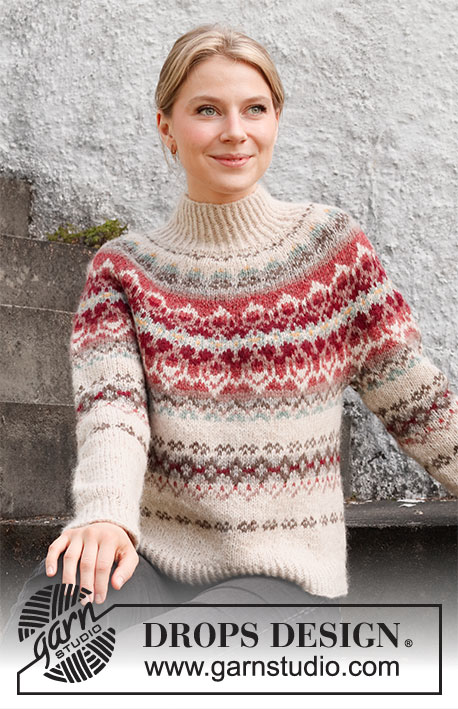 |
||||||||||||||||||||||||||||||
Knitted jumper in DROPS Air. The piece is worked top down, with round yoke and Nordic pattern. Sizes S - XXXL.
DROPS 217-1 |
|||||||||||||||||||||||||||||||
|
------------------------------------------------------- EXPLANATIONS FOR THE PATTERN: ------------------------------------------------------- PATTERN: See diagrams A.1 to A.3. The whole pattern is worked in stocking stitch. KNITTING TIP: To avoid the knitting tension becoming tighter when working pattern, it is important that the strands at the back are not tight. Use a size larger needle when working pattern if this is a problem. If the knitting tension is not correct in height and you work too tightly, the garment will be short and the armholes too small – you can correct for this by regularly working an extra row in the 1-coloured sections. If you work loosely, the garment will be too long – you can correct for this by regularly working 1 round less in the 1-coloured sections. INCREASE TIP (evenly spaced): To work out how to increase evenly, count the total number of stitches on the needle (e.g. 80 stitches) and divide by the number of increases to be made (e.g. 22) = 3.6. In this example, increase by making 1 yarn over after alternately each 3rd and 4th stitch. On the next round, knit the yarn overs twisted to avoid holes. DECREASE TIP (for mid under sleeve): Decrease 1 stitch on either side of the marker thread as follows: Work until there are 3 stitches left before the marker thread, knit 2 together, knit 2 (marker thread sits between these 2 stitches), slip 1 stitch as if to knit, knit 1 and pass the slipped stitch over the knitted stitch. CASTING-OFF TIP: To avoid the cast-off edge being tight you can cast off with a larger size needle. If the edge is still tight, make 1 yarn over after approx. each 4th stitch at the same time as casting off; the yarn overs are cast off as normal stitches. ------------------------------------------------------- START THE PIECE HERE: ------------------------------------------------------- JUMPER – SHORT OVERVIEW OF THE PIECE: The neck and yoke are worked in the round with circular needle, from the transition between the left sleeve and the back piece and top down. The yoke is divided for the body and sleeves and the body continued in the round with circular needle. The sleeves are worked in the round with short circular needle/double pointed needles, top down. NECK: Cast on 80-84-88-94-96-102 stitches with circular needle size 4.5 mm and wheat. Knit 1 round then work rib (= knit 1 twisted / purl 1) in the round for 9 cm. When the rib is finished, knit 1 round where you increase 22-24-26-26-30-36 stitches evenly spaced – read INCREASE TIP = 102-108-114-120-126-138 stitches. Change to circular needle size 5.5 mm and insert 1 marker at the beginning of the round; the yoke is measured from this marker! YOKE: Work pattern A.1 (= 6 stitches) a total of 17-18-19-20-21-23 times on the round – read KNITTING TIP. On the rounds with arrows, increase as follows - remember INCREASE TIP: Arrow-1: Increase 24-24-30-30-30-30 stitches evenly spaced = 126-132-144-150-156-168 stitches. There is now room for 21-22-24-25-26-28 repeats of A.1 on the round. Arrow-2: Increase 14-22-24-18-19-21 stitches evenly spaced = 140-154-168-168-175-189 stitches. REMEMBER THE KNITTING TENSION! Now continue in the different sizes as described below: Sizes S and M: Work A.2 (= 7 stitches) a total of 20-22 times on the round. When the piece measures 22-24 cm, sizes S-M are finished. If the knitting tension is correct there are 4-0 rounds left in A.2 and 240-264 stitches on the round. If the piece is shorter than 22-24 cm, continue with the remaining rounds in A.2 and then A.3 over A.2 (there is room for 2 repeats of A.3 over the 12 stitches in A.2) to the correct length. Sizes L and XL Work A.2 (= 7 stitches) a total of 24-24 times on the round. When the diagram has been worked in height there are 288-288 stitches on the round. If the knitting tension is correct the piece measures 24-24 cm from the marker. Continue with A.3 over A.2 (there is room for 2 repeats of A.3 over the 12 stitches in A.2) until the piece measures 25-26 cm from the marker. Sizes XXL and XXXL: Work A.2 (= 7 stitches) a total of 25-27 times on the round. When the diagram has been worked in height there are 300-324 stitches on the round. If the knitting tension is correct the piece now measures 24-24 cm from the marker. Continue with A.3 over A.2 (there is room for 2 repeats of A.3 over the 12 stitches in A.2) until the piece measures 28-30 cm from the marker; at the same time on row 8 in A.3 increase 12-12 stitches evenly spaced = 312-336 stitches. All sizes: Now divide the piece for the body and sleeves. To give a symmetric pattern on the front and back pieces, the beginning of the round is moved back 3 stitches in sizes M and XXXL (i.e., cut the strand and place the first stitches on the right needle onto the left needle before continuing). In sizes S, L, XL and XXL keep the beginning of the round where it is. Work the next round in pattern as before and as follows: Work the first 72-78-84-84-96-102 stitches (= back piece), place the next 48-54-60-60-60-66 stitches on a thread for the sleeve and cast on 6-6-6-12-12-12 new stitches (= in side under sleeve), work the next 72-78-84-84-96-102 stitches (= front piece) and place the next 48-54-60-60-60-66 stitches on a thread for the sleeve and cast on 6-6-6-12-12-12 new stitches (= in side under sleeve). Body and sleeves are finished separately. THE PIECE IS NOW MEASURED FROM HERE! BODY: = 156-168-180-192-216-228 stitches. Continue in the different sizes as follows: Size S: Insert a marker thread in the middle of the 6 new stitches cast on under each sleeve (= 3 stitches on each side of the thread). Continue with A.2 as before until the diagram has been completed in height – NOTE: The pattern does not fit under the sleeves; work as many stitches of pattern that there is room for under sleeves. Work A.3 (= 6 stitches) a total of 26 times on the round. When A.3 has been completed go to ALL SIZES. Sizes M, L, XL, XXL and XXXL: Continue with A.3 (= 6 stitches) a total of 28-30-32-36-38 times on the round. When A.3 has been completed go to ALL SIZES. ALL SIZES: After A.3 continue with wheat to finished length. When the piece measures 26-26-27-28-28-28 cm from the division, knit 1 round where you increase 28-30-32-32-36-38 stitches evenly spaced = 184-198-212-224-252-266 stitches. Change to circular needle size 4.5 mm and work rib (= knit 1 twisted, purl 1) for 4 cm. Cast off with knit over knit and purl over purl - read CASTING-OFF TIP. The jumper measures approx. 56-58-60-62-64-66 cm from the shoulder down. SLEEVE: Place the 48-54-60-60-60-66 stitches from the thread on the one side of the piece on double pointed needles/short circular needle size 5.5 mm and knit up 1 stitch in each of the 6-6-6-12-12-12 stitches cast on under the sleeve = 54-60-66-72-72-78 stitches. Insert a marker thread in the middle of the 6-6-6-12-12-12 stitches under the sleeve. Allow the thread to follow your work onwards; it will be used when decreasing under the sleeve. Continue in the round with pattern, in the same way as on the body – the pattern will not fit under the sleeve. When the sleeve measures 5-3-3-3-3-3 cm from the division, decrease 1 stitch on either side of the marker thread - read DECREASE TIP. Decrease like this every 3½-3-2½-2-2-1½ cm a total of 9-11-13-15-14-17 times = 36-38-40-42-44-44 stitches. Continue working until the sleeve measures 37-36-35-34-33-31 cm (shorter measurements in larger sizes due to longer yoke). Knit 1 round where you increase 6-6-6-6-8-8 stitches evenly spaced = 42-44-46-48-52-52 stitches. Change to double pointed needles size 4.5 mm and work rib (= knit 1 twisted, purl 1) for 5 cm. Cast off with knit over knit and purl over purl - remember CASTING-OFF TIP. Work the other sleeve in the same way. |
|||||||||||||||||||||||||||||||
Diagram explanations |
|||||||||||||||||||||||||||||||
|
|||||||||||||||||||||||||||||||
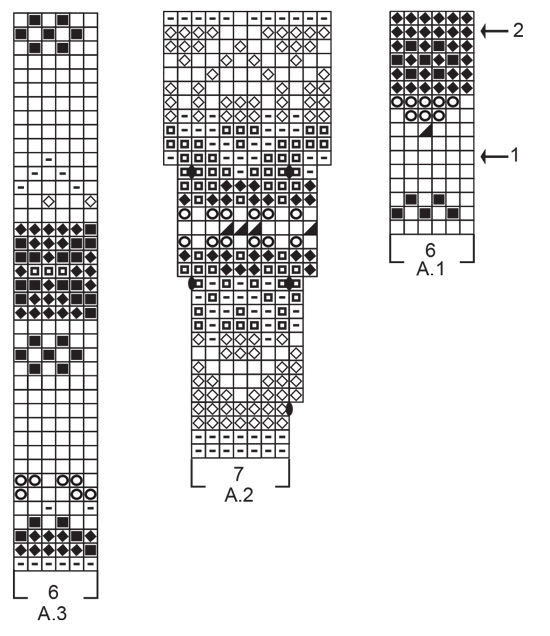 |
|||||||||||||||||||||||||||||||
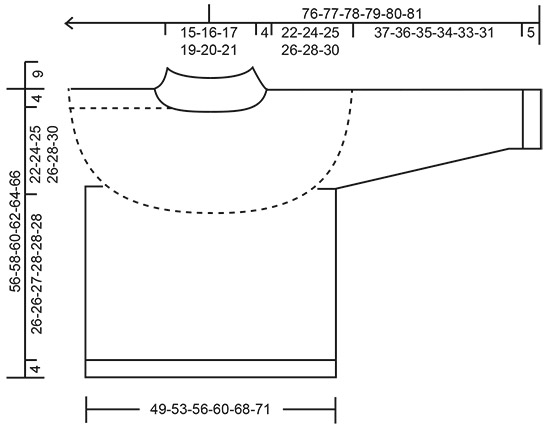 |
|||||||||||||||||||||||||||||||
Have you finished this pattern?Tag your pictures with #dropspattern #mistletoemusesweater or submit them to the #dropsfan gallery. Do you need help with this pattern?You'll find 26 tutorial videos, a Comments/Questions area and more by visiting the pattern on garnstudio.com. © 1982-2025 DROPS Design A/S. We reserve all rights. This document, including all its sub-sections, has copyrights. Read more about what you can do with our patterns at the bottom of each pattern on our site. |
|||||||||||||||||||||||||||||||








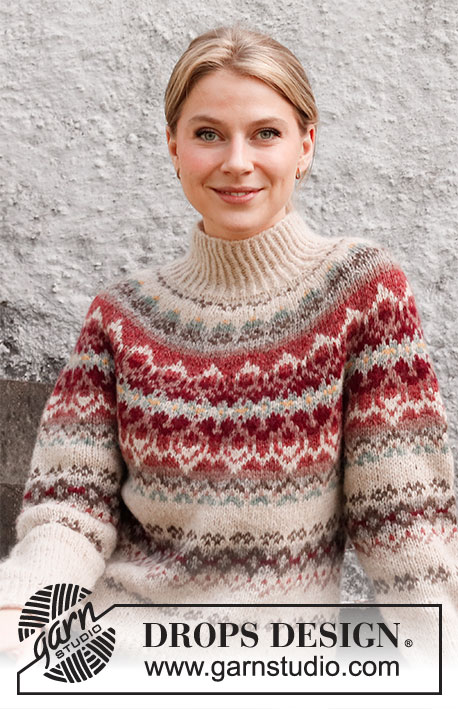


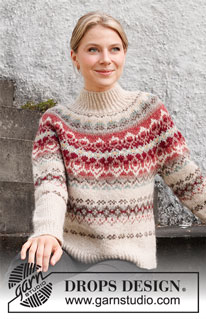
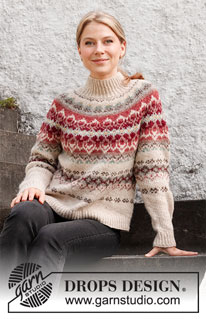
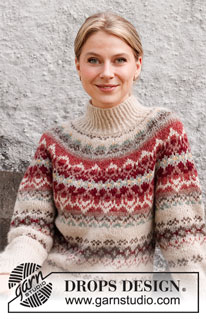





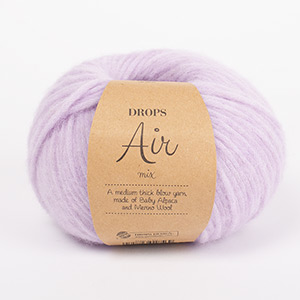
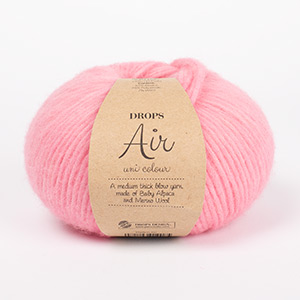

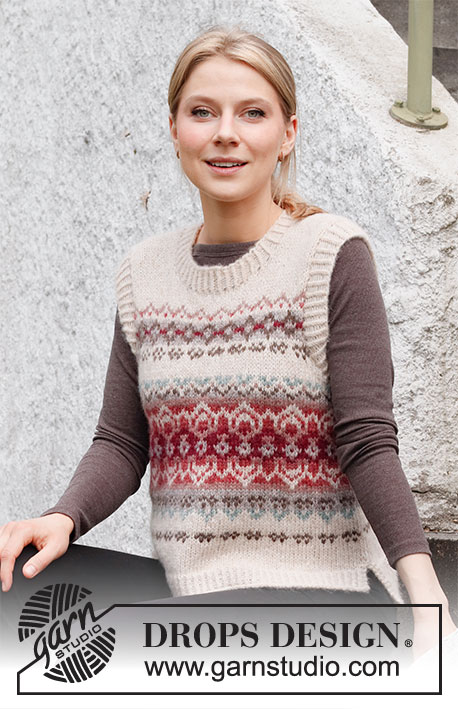























































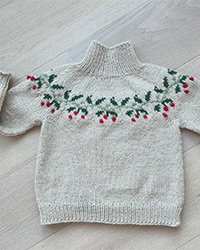
Post a comment to pattern DROPS 217-1
We would love to hear what you have to say about this pattern!
If you want to leave a question, please make sure you select the correct category in the form below, to speed up the answering process. Required fields are marked *.